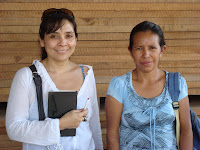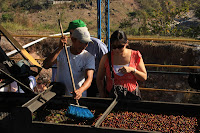It was almost 4:00am (Dutch time) when I was ready to go to sleep. I woke up very early because of the rain. First thing I thought was: "Oh, my…! It is the dry season, but it is raining a lot". And then I found out a study tour participant did not arrive yesterday as planned. Her flight was cancelled because of the snow storm in New York, which I’ve learned has been the worst in years.
Lately there have been natural disasters and weather irregularities affecting people, communities and even whole nations in Central America and worldwide. More tropical storms and hurricanes, extreme cold temperatures, sever droughts, and heavy rains are continuously reported in the media. We continuously hear this wake up call, but… are we taking it seriously? Not only individuals, but also sectors and institutions are accountable for climate protection, fostering environmental-friendly and sustainable practices. Truth is that everybody can put its two cents before there’s a point of no return. How many of us are doing it actually?

A windy Guatemala city (from the hotel)
As I think of the project partners to be visited in the coming days - fair trade, organic coops, sustainable timber company, MFIs working in rural areas, and agri-processing companies using clean energy, - and many others that could have qualified for the study tour, it is clear Oikocredit has taken its role and responsibility as social investor seriously and long before "green", 'environmental-friendly", and "sustainable" was a household name in the among financiers in the microfinance sector. One example is the Mexico, Central America, and the Caribbean region, which is one of the leading Oikocredit regions in financing project partners with practices aiming to reducing or lowering their impact on the environmental criteria.
Rain has not stopped yet. Where did I put my umbrella?
 The study tour 2011 is over. It’s time to say good bye to and thank everybody who participated in many ways in the study tour. It has been wonderful to share this experience with all of you.
The study tour 2011 is over. It’s time to say good bye to and thank everybody who participated in many ways in the study tour. It has been wonderful to share this experience with all of you.






 It was nice walking in the Maya Biosphere Reserve. I am glad these communities are preserving the forest while also making a living. Thanks to sustainable forestry practices future generations would also get the chance to enjoy this beautiful environment.
It was nice walking in the Maya Biosphere Reserve. I am glad these communities are preserving the forest while also making a living. Thanks to sustainable forestry practices future generations would also get the chance to enjoy this beautiful environment.
















